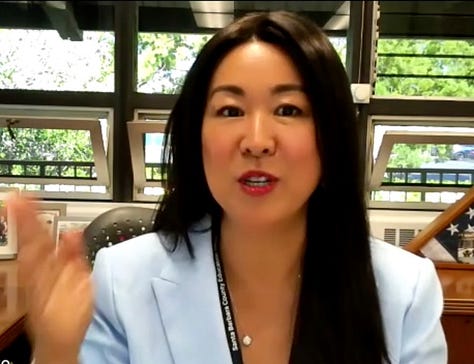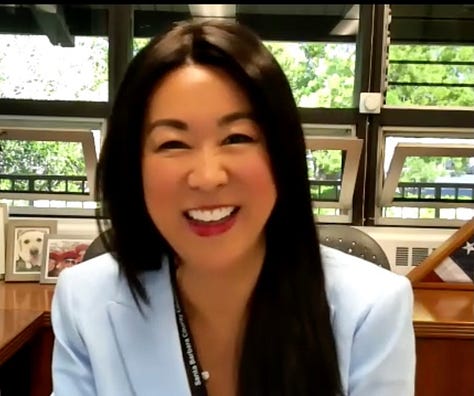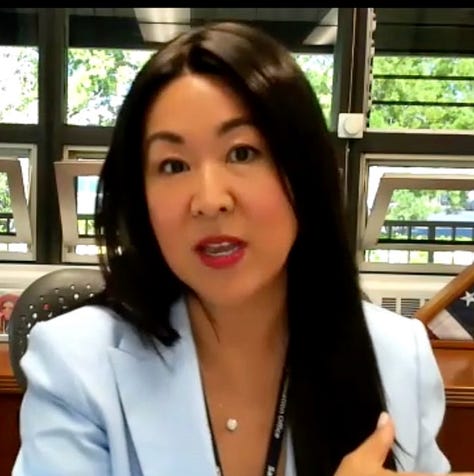How SB County Schools Chief Stays Hopeful, as Trump Takes Aim at California and Public Education
Superintendent Susan Salcido acknowledges students' "fear, worry, anxiety" but remains optimistic about school resilience despite federal threats on immigration, funding and civil rights



For Susan Salcido, an idealistic and upbeat public education lifer, Back to School Week for most of her professional life has been the most joyful time of the year.
As the 2025-26 school term began this week, however, Santa Barbara County’s Superintendent of Schools acknowledged that she is tempering her “Pollyanna” tendencies, as she works to put in place practical and credible strategies for responding to threats arising from Donald Trump’s political and legal assault on the State of California, its financing of public education and the security and welfare of 70,000 kids just trying to go to school in the richly diverse districts she oversees.
“There’s a fine line between positivity and optimism and Pollyanna,” Salcido said in a one-on-one interview on Friday.
“I don't want to subscribe to Pollyanna and head in the sand, but I do want to subscribe to optimism, positivity, hope, and really believing that there is common ground, still,” she said in her return to Newsmakers TV.
“And I know that it can feel like we're all just on one side or the other, and you're either with me or you're against me. And we just can't have that in our public schools - we have to be on common ground focusing on every individual.”
Wait - we have a county superintendent? Salcido has served since 2017 as county superintendent, a low profile but crucially powerful elected position.
She heads the $100 million County Education Office, which she describes as working “interdependently but independently” with 20 local superintendents and districts (like Santa Barbara Unified). That’s where most specific decisions about curriculum and classrooms are made, but the county office exercises broad duties and responsibilities over administration, overseeing, interpreting and helping implement policies set in Sacramento, where most of the money for local schools originates:
For a full explanation of the Delphic and arcane operations of the CEO, see our 2022 interview with Salcido:
Overseen by a low-profile, seven-member county Board of Education elected by district, the County Education Office in large measure is an administrative government agency, acting on behalf of local school districts as a clearinghouse, pass-through, analyst, interpreter and liaison with California's maddeningly complex state public education system.
In normal times, it’s a complicated but rule-based, process, protocol and procedure type operation.
These are not normal times, however: Salcido now faces a host of unprecedented policy, political, and legal challenges thrown up by a White House that displays scant regard for the rule of law, let alone values and norms, and simply doesn’t play by the rules.
The ICE challenge. Most urgently, in a county where 70 percent of public school students are Latino, she is contending with multiple difficulties triggered by roving gangs of masked and heavily armed federal immigration agents Trump set loose in California (and who according to a federal court ruling, have, cruelly and indiscriminately, racially profiled and targeted people throughout California). These issues range from the mental health of students traumatized by witnessing ICE gangs at work, to survival needs of kids whose families have suddenly been ripped apart by MAGA’s militarized deportation campaign.
“There's a lot of connecting and navigating to families,” Salcido said. “That is one of the hardest components when you see a student coming to school. I've had firsthand accounts of this, from people who are saying, ‘the first grader’s in my office crying and worried.’
“So that fear and the worry and the anxiety that we're hearing about, we are hearing about in schools as well,” she said.
Most chilling is the scenario planning that public school administrators are being forced to carry out against the possibility of Immigration and Customs Enforcement (ICE) agents showing up on a campus, despite long-standing prohibitions.
“We've been thinking about, planning for, and talking with staff about what happens if ICE individuals or Border Patrol come onto campus,” the superintendent said.
“And I have to tell you, it's hard for even an aunt, or uncle, or neighbor to come by and pick up a child who's not on their emergency form,” she added. “So we've got a real strong grasp of safety and who is seeking information at all, or actually seeking or maybe removing a student.
“So there's a lot of talk about that,” Salcido told Newsmakers. “But then there's the other piece that…we're seeing happen already, which is the unaccompanied minors, those who've been separated from their caregivers, grandparents or parents.
“And that becomes another challenge because…the students are coming to school not thinking about math and reading and science and art and playing. They're thinking about, when am I going to see my family again?”
In our conversation, Salcido also addressed several other key issues with which she is contending amid Trump’s attacks on California, its finances, its values, its students, and its elected officials:
Civil rights. In response to questions about Trump’s white grievance bid to dismantle long-time legal precedents and policies established to protect the interests and improve the lives of people who suffered discrimination — now lumped together and smeared as “DEI” — Salcido defended the underlying values of “diversity and equity and inclusion” and decried the political tribalism that she sees harming children.
“We have to really put our energy towards that common ground for all students and diversity and equity and inclusion. This somehow turned into ‘DEI: Bad/Good.’”
“It seems like DEI has been placed somewhere here (gesturing) and you're either for it or against it. And making that a binary problem just doesn't seem to make sense to me.
“No, diversity, equity, inclusion is what we do — and have done in public schools since the beginning of time. Let's use common sense in finding common ground.”
Funding cuts. The Administration has slashed funding for the U.S. Department of Education, in the process threatening programs for children with disabilities, English Learners and a host of others. Salcido said the chaos and confusion surrounding the swift move on education funds has left local administrators “scrambling.”
“The federal Department of Education and its impacts on public schools are vast. And…there is federal funding that was allocated and then taken back or, I should say, stated that it was coming and then taken back…impounded…
“So when you have those plans in place, but then things pivot dramatically and quickly all over the place, that becomes a scramble and that's a challenge.”
Enrollment and absenteeism. Salcido offered updates on the local manifestations of a national decline in enrollment and an increase in chronic absenteeism that began during the long period of the pandemic, when many schools were closed.
“I've been really tracking the enrollment in Santa Barbara County and school districts across the county and for the longest time…there were about 69,000 students across Santa Barbara County. Then five years ago, right at Covid, there was a drop of about 2,000 students, so about 67,000 students across Santa Barbara County. And that number has stayed pretty consistent.
“We're seeing some increases in some districts….in the Santa Maria Valley and the northern part of Santa Barbara County, we're seeing enrollment increases, pretty dramatic enrollment increases…So pretty big schools in Santa Maria, increasing enrollment, slightly decreasing in the South Coast. And what we are seeing are impacts of incoming housing developments. We know that there's a nexus between upcoming housing developments…and that will bring enrollment increases to our schools.”
Bottom line. To her credit, and the benefit of the students whose education she plays a large part in shaping, Salcido remains steadfast and positive in navigating a whole new set of challenges no one foresaw when she was earning her Phd at USC years ago.
Her North Star remains this: “We really want to focus on school —people want to focus on children being in our schools every day, feeling great, feeling happy, ready to learn.”
“We would never have predicted where we are today, but now is when we need everyone to come together, and now is when we need to support our schools and absolutely teach our children,” Salcido said.
“We need to have the joyful learning,” she added. “When you drive by or walk by a school at recess, you want to hear the playing and the laughing. That's what we need. We need to protect our children from all of this by having that common ground.”
Check out our full conversation with Susan Salcido via YouTube below, or by clicking through this link. The SB Newsmakers podcast is available on Apple, Spotify and on Soundcloud here. TVSB, Channel 17, airs Newsmakers TV every weeknight at 5 p.m. and at 9 a.m. on weekends. KCSB, 91.9 FM, broadcasts the program 5:30 p.m. Mondays.

